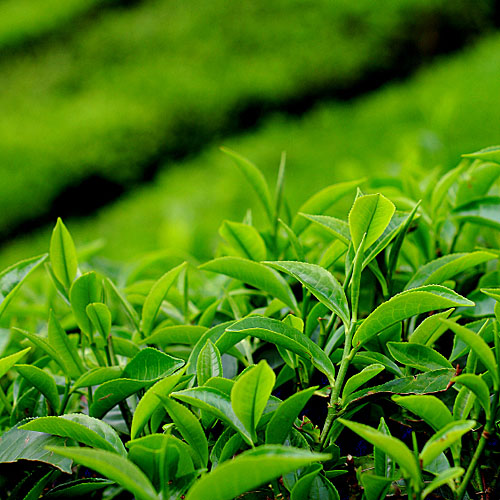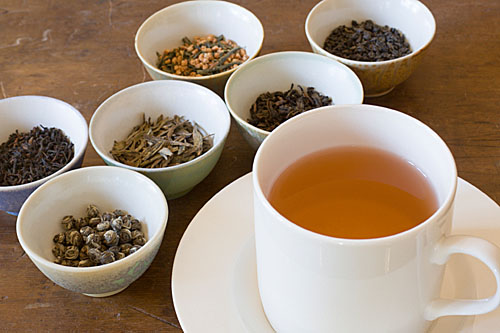| Before we go any further, if you have ever used the phrase 'herb tea', please first ritually flaggelate yourself and then allow me to introduce you to Camellia Senensis:

More commonly referred to as the tea-plant.
There are a great variety of teas - over 3000, in fact. All of them have one thing in common: they are made from the leaves or buds of some variant of Camellia Senensis. Tea, by definition, is made from, well, tea.
There is no such thing as 'herb tea'. There are herbal infusions, which are hot drinks made in a similar fashion to tea. I am on a one-man mission to forever eradicate from the English language the phrase 'herb tea'. I shall not rest until this has been achieved. Please tell your friends.
I'm glad we had that little chat. Now, back to tea ...
Types of tea
There are four main types of tea: black, green, oolong and white. All come from the same plant, they are just harvested and processed in different ways.
Black tea
All of the traditional British teas are black tea. Black tea was originally from China (where, just to confuse us, it is known as red tea). The tea leaves are first laid out on bamboo racks to soften them sufficiently to be rolled without tearing the leaves. The leaves are then rolled - the exact way in which this is done will determine the strength and flavour of the finished product. The rolled leaves are then left in cool and humid rooms to oxidise. Finally, the oxidised leaves are dried, usually by oven baking.
Green tea
Prepared in a similar way to black tea, but skipping the oxidisation stage.
Oolong tea
Here the leaves are softened as usual, but then shaken and allowed to dry naturally, a cycle that is repeated several times. Drying continues until the leaves are slightly yellow. The other differences from black tea is that the oxidation time is reduced by about half, and the final drying stage is done at a higher temperature.
White tea
White tea, sometimes referred to as the king of teas, is made entirely from leaf-buds, rather than fully-developed leaves. The name derives from the white hairs that cover the buds. The buds are not rolled, and only very slightly oxidised, to produce an extremely delicate tea which tastes something like a cross between black and green tea.
My favourite black teas
The teas I tend to have in my kitchen are:
English Breakfast Tea
A robust blend of Assam, Ceylon, Kenyan and Keemun teas, ideal for waking up in the morning.
Afternoon tea
A medium-bodied blend of Ceylon and Keemun.
Assam
The most common type of tea. Grown in the Assam region of India, most ordinary teas and breakfast teas are made wholly or mostly from Assam tea. Buying tea specifically sold as Assam usually just gets you a higher quality version of what is otherwise sold as generic tea.
Earl Grey
My mainstay! The blend can vary, but the defining characteristic of Earl Grey is the addition of Bergamot oil, extracted from the rind of the orange of the same name.
Lady Grey
A more delicate variation of Earl Grey in which the potent Bergamot is blended with oils from Seville oranges and also lemons. It has a gentler flavour with more of a citrus twang.
Tarry Lapsang
Genuine Lapsang is made only from tea from the Mount Wuyi area of the Fujian province of China. The characteristic smokey flavour is created by drying it in bamboo baskets over burning pine. The smokiest of all is Tarry Lapsang, smoked over pine tar. My top tip with Lapsang is not to attempt to order it in a small hotel in a small town in Yorkshire, as the waitress will stare at you like you'd just asked her to produce Einstein's original handwritten notes for the Special Theory of Relativity.
Darjeeling
A slightly musky-tasting Indian tea from the Bengal area.
There is much written about tea-making, some of it based on fact, some more on superstition. It is, however, science to stress the importance of using water that is (a) boiling and (b) freshly-boiled. It is the act of boiling that releases the oxygen in the water which helps to bring out the flavour of the tea. If the water isn't boiling, or you repeatedly boil the same kettle-full, you'll get flat-tasting tea.
My pushers
Tea qualities vary enormously. I get my teas from Imperial Teas in Lincoln and from the Tea Palace in Covent Garden. |

